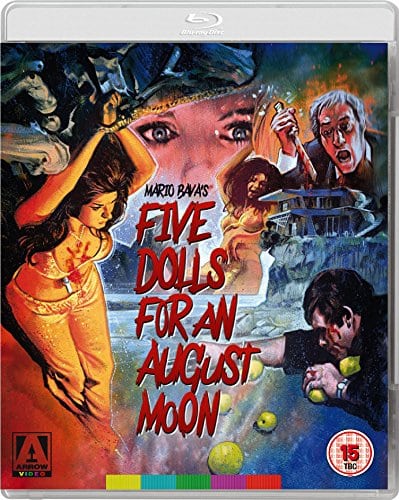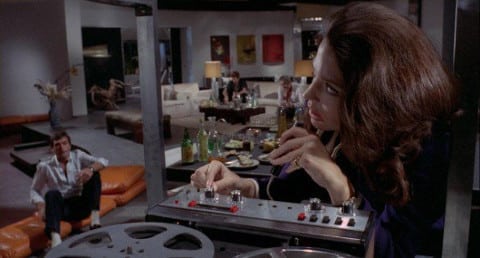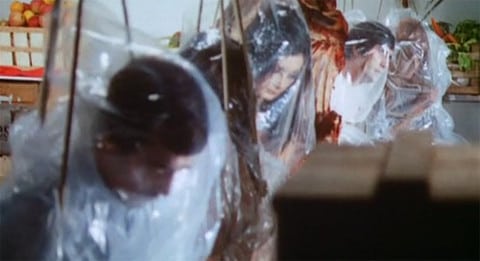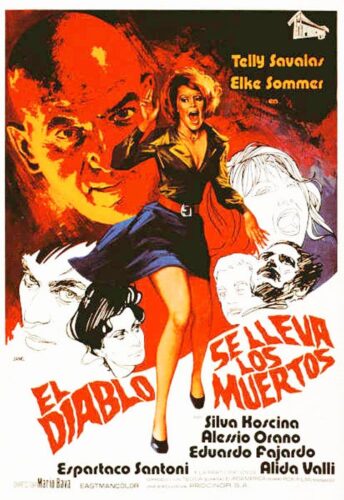Five Dolls for an August Moon (1970)
Directed by: Mario Bava
Written by: Mario di Nardo
Starring: Edwige Fenech, Howard Ross, Ira von Fürstenberg, William Berger
Italy
AKA 5 BAMBOLE PER LA LUNA D’AGOSTO
ON DUAL FORMAT: NOW, from ARROW VIDEO
RUNNING TIME: 81 min
REVIEWED BY: Dr Lenera, Official HCF Critic

At the private island retreat of wealthy industrialist George Stark, a group of people have assembled for a weekend getaway. There’s Professor Gerry Farrell, his wife Trudy, Stark’s artist wife Jill who is having an affair with Trudy, Stark’s business partner Nick who verbally abuses his coquettish wife Marie but doesn’t object to her sleeping with other men [one of whom is the houseboy Charles], Isabelle, a teenage girl in Stark’s care while her parents are away, and the sole happy couple, Nick’s co-worker Jack and his wife. Peggy. Farrell is enraged to discover that Stark and several of the guests planned the weekend to coerce him to sell his latest invention: a formula for industrial resin. Then Jill discovers the dead body of Charles on the beach, and it won’t be the last….
My monthly Mario Bava review series on HCF drags to a halt ever now and again because of the piles of screeners we have lying around waiting to be reviewed, but luckily amongst this month’s lot to do are two films from this wonderful director [If you’ve regularly read our reviews you’ll probably be tired of me singing his praises], and Five Dolls For An August Moon is the first. Conveniently, this was the next Bava film I was going to review anyway, ever since the showing over Christmas of the BBC’s very fine adaptation of Agatha Christie’s And Then There Were None, which as far as I know is the first English language production to use Christie’s dark ending, and recalled Bava’s film as a variant on Christie’s tale. Partly due to the circumstances of its production, Bava himself didn’t like the result, once calling it his worst movie, which is probably why he partially reworked it for his next film, the much better known Bay Of Blood [aka a hundred different other titles], but I think he’s a little hard on it. It’s certainly not one of his unsung masterpieces, and definitely not the place to begin if you’re new to The Father Of Italian Horror, being probably his strangest work after Lisa And The Devil, but there’s a lot of fun to be had with it, with style to burn and an entertainingly twisty plot. It’s also slyly subversive in some respects, such as the fact that, despite featuring several murders and having most of its characters sleeping with someone other than their partner, it refuses to show much in the way of sex or violence….though don’t let that put you off, as the film is rarely dull.
The original director for this film, who was probably Guido Malatesta though this hasn’t been officially stated, left the production a few days before shooting was about to commence, probably because of ill health. Bava had been offered the project months before, and, hating the script, had turned it down, but was now offered it again, on a Saturday, with filming to begin on the following Monday. Bava’s request for 12 days of preparation and extensive script re-writes were refused. He did, though, have time to make a few alterations to the screenplay, notably having the dead bodies be placed in a meat freezer rather than be buried underground, and changing the ending. The long shot exteriors of the Stark house were a glass painting mounted on the same cliff as the Menliff castle in The Whip And The Body, while much of the outdoor footage was filmed at Bava’ s favourite beach there, Tor Caldara in Anzio. A scene of Edwige Fenech’s character running a long distance was actually her running in circles around some foliage being moved by technicians, as the locale was too small. The film suffered from interference from the producers throughout, but Bava, who for the only time did his own editing, did his best over the 19 day shoot to make the movie something of his own. It was released in Italy to little success, and also in Turkey and the UK, but was the only Bava film [unless you count his original version of Lisa And The Devil] not to get a US theatrical release until the unfinished Rabid Dogs. It passed into near obscurity.
Now I have no idea what Four Dolls For An August Moon actually means, aside from the fact that there are five female characters in it, but this was the golden age of the giallo and Italian cinemas were filled with thrillers sporting weirdly descriptive titles of a similar kind, something begun by The Bird With The Crystal Plumage, though most of those actually related to the plot a bit more. The film opens with delightfully cheesy Hammond organ music as the titles occur over a beautifully shot sequence of a woman walking on a beach and in the water. This woman is Isabelle, and throughout the film she is constantly prying while the other characters don’t seem to notice her. I’m not even sure where she actually sleeps [the beach?], but then reality takes a back seat in this movie quite quickly so this kind of thing can hardly be criticised for being unbelievable. We are then introduced to our other characters with rapid zooms [and you’d better get used to this – Bava really had a love affair with the zoom lens in this movie], as they gather in the main room of the house, irresistibly groovy though weird lounge-style music spinning on a record player, and one of their number, Marie, dances seductively. The men are understandably watching her with obvious lust, while the women seem to be lost in their little worlds. Then they play an odd game where they pretend to sacrifice Marie to a pagan god and someone turns out the lights….which, when turned back on, reveal Marie to have been stabbed to death….only it’s all pretend! This doesn’t really have any bearing on the main plot, and one wonders why the scene’s in the film, but never mind!
Soon the first dead body turns up, and Bava’s sense of humour is evidenced by his close-ups of all the people looking down at the corpse, saying that any one of them [or more] could be guilty of the terrible crime. The film then stalls for a bit while the characters are either fighting over Stark’s resin formula [little more than an Alfred Hitchcock-style MacGuffin – something which propels the plot but is essentially meaningless] or in bed with each other, though the gloriously tacky interior design, cleverly construced to use up as little money as possible and still be quite striking, and often seemingly composed of squares, helps to keep us watching. Then somebody else is killed….and this time we see the murderer….or do we? It’s probably no surprise to say that the story gets very convoluted, though in the end it is quite cleverly put together, with a wicked twist ending, even if a few things don’t seem to make much sense in the light of day. Bava doesn’t seem very concerned with ramping up the suspense, but then the whole thing is rather tongue in cheek really, especially with the way the dead bodies mount up in the meat storage freezer, these moments even accompanied by a light hearted musical theme, and Bava does generally pace this film quicker than normal, scenes tending to be short and to the point rather than the languid, drawn out set pieces that were a major feature of many of his other pictures.
While we only see the aftermath of most of the killings [though there’s a few gruesome shots] and the most extreme example of decadence is when somebody smokes a cigarette held between two of his bed partner’s toes, Bava makes up with sheer directorial style for the sake of it. Yes, the zooming gets a bit tiresome, but there’s much use of other techniques and even some genuine experimentation, like a shot of the reflection of a woman sitting in a room which is totally out of focus but still seems very artfully composed. While Five Dolls For August Moon still fits in with Bava’s other work, with two of his favourite themes – his cynical view of humans as greedy and untrustworthy, and the deceptive nature of appearances – it’s really as if Bava and his camera operator Antonio Rinaldi decided to use their dissatisfaction and frustrations with the film to just have fun, and this approach seems entirely fitting. After all, there’s a sequence of jaw dropping oddness when some sailors arrive on the island to check up on everyone and find nothing, despite the fact that in the previous scene we’ve seen some of them asleep in a drunken stupor in a very messy lounge which now seems totally clean. The sailors go, then there’s a cut to back the lounge as how it was before again, the sleepers awaken, and one of them even plays a tape recording of the sailors talking! Then there’s the irrelevant but highly memorable scene where a fight, shot partly through a partition, and partly with very modern-style editing, knocks over a table containing loads and loads of marbles, and we follow them as they go down the stairs and even reveal the next corpse! With stuff like this, plus some especially gorgeous blue-tinged [in fact blue is used throughout] photography where Bava even manages to make what is the obvious fakery of what looks like day-for-night shooting into a good thing, it doesn’t matter that much that the characters are thin and not very interesting.
In fact the acting is only so-so, though this is often the case with the films that Bava wasn’t enamoured by. Of course it’s always a joy to see Edwige Fenech [in fact, for this male viewer, all the women are especially delectable in this movie], even if not nude [except for one fleeting second] this time. The fun is rounded off by Piero Umiliani’s score, which ranges from organ to whistling and seems to be almost constantly in the background, often blurring the distinction between score and source music, and constantly adding its own ironic commentary to the action. Some of the more dance-like pieces should be required playing at any dinner party. There are certainly times where Five Dolls For An August Moon shows sign of its rushed production, such as when the reflection of a character can be seen in a foreground glass painting, and during a few examples of jarring editing, while it could have been a lot more gripping and even scary, but it’s a highly entertaining watch nonetheless. Don’t try to take it too seriously, and don’t expect lots of blood or to be on the edge of your seat, and you may have a really good time with it. And….oh yes….J & B whisky is present and correct, two bottles shown on three occasions, with one character drinking the stuff straight out of the bottle!
Rating: 









Arrow’s restoration work for Blu-ray is generally second to none, so it’s a bit of a shame when one of their titles doesn’t look anything less than stellar, though the occasional pops, scratches and a very distracting vertical line appearing a few times may be because of the poor state of the original print. Five Dolls For An August Moon still looks very good and far better than my old Anchor Bay DVD of the film. As usual with these films, many of the performers appear to be speaking English, but the Italian langauge track seems to flow better than the English one. While Arrow have not given us a shed load of special features this time, the commentary track by Bava expert Tim Lucas, ported over from the Region A Kino Lorber Blu-ray, which only contained the English language track, is typically excellent and provides all the information and analysis you could probably wish for, while this version gets another one over on the American one by adding Mario Bava: Maestro of the Macabre, a good hour long TV documentary on Bava which has appeared on a few old DVD releases of Bava’s films.
SPECIAL FEATURES
*High Definition Blu-ray (1080p) and Standard Definition DVD presentations
*Optional English and Italian soundtracks presented in original uncompressed mono PCM audio
*Optional isolated Music and Effects track
*Optional English subtitles for the Italian audio and English subtitles for the deaf and hard of hearing for the English audio
*Audio commentary by Mario Bava’s biographer Tim Lucas
*Mario Bava: Maestro of the Macabre – a documentary profile of the director, hosted by Mark Kermode and featuring interviews with Joe Dante, John Carpenter and Tim Burton
*Theatrical trailer
*Reversible sleeve featuring original and newly commissioned artwork by Graham Humphreys
*Illustrated collector’s booklet featuring new writing on the film by Glenn Kenny and a new essay by Adrian Smith on the Fancey family and their efforts to bring international exploitation titles, including Five Dolls for an August Moon, to a UK audience during the 60s, 70s and 80s







Be the first to comment